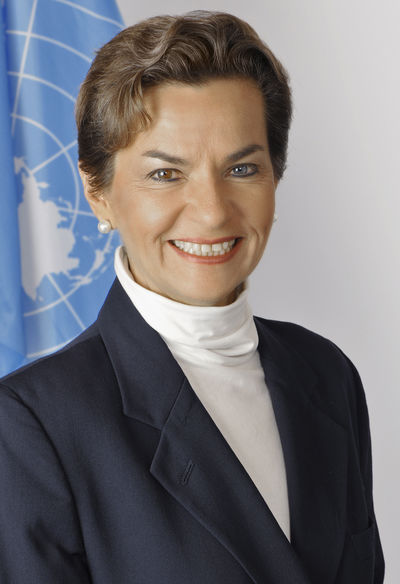Christiana Figueres: A Pathway Toward Carbon Neutrality
Interview with Ms. Christiana Figueres, Executive Secretary of the UN Framework Convention on Climate Change (UNFCCC).
04.11.2014

Dear Ms. Figueres, you are from Costa Rica. People there typically use the term “Pura Vida” (pure life) as an expression of optimism. How much does the Pura Vida attitude help you when you sometimes find yourself in frustrating political negotiations?
Christiana Figueres: Well, at this point during the World Cup, we Costa Ricans are particularly optimistic. But the fact is that it is an optimistic country that is always in the market for miracles. We are actually quite risk-friendly, which is probably why Costa Rica has served as a model for other countries, in particular on climate change policy and on payments for environmental services – two items that were piloted in Costa Rica and are now being used in many other countries. But my optimism is not just because of my wonderful country; it is also because, from my vantage point, I see so much progress on climate policy. I see 500 climate change laws around the world. I see investment in renewable energy technologies and the scaling-up of energy efficiency. I see the cost of renewable-energy technologies going down. So I see many different factors that are leading both to an increased number of policy measures and also to an increase in possibilities for being able to effectively implement those policies, reduce emissions, and increase resilience.
The chances of limiting global temperature increases to 2 degrees Celsius during this century are diminishing. Experts such as Hans Joachim Schellnhuber, from the Potsdam Institute, are warning that we are rapidly approaching irreversible tipping points. How much time is left for a political solution?
Figueres: We are rapidly approaching very, very dangerous zones, so one should not be rosily optimistic nor irresponsible about the decisions that we have to make. But the Intergovernmental Panel on Climate Change (IPCC) assessment report is very clear in establishing the pathway that we need to follow in order to keep temperature increases below 2 degrees Celsius. That pathway points out very clearly that we must reach global peak emissions within the next 6 to 10 years. We must achieve global carbon neutrality in the second half of the century. The IPCC warns us that the deadline for making this change is actually very soon. But we still a have chance to do it. That is why the Lima draft agreement and the Paris Agreement are so critical.
In the latest report from the IPCC, Chris Field, from the Carnegie Institution for Science, said that he sees progress. But the progress described has not been in mitigating carbon emissions but rather in adapting to the effects of global warming. Is this the new realpolitik of the United Nations?
Figueres: The reason why adaptation is now commanding much more attention – as it should – is because global greenhouse gas emissions continue to rise, and there is a direct relationship between the two. The more that greenhouse gas emissions rise, the more adaptation is going to become necessary, and vice versa. The quicker we can lower the levels of greenhouse gas emissions, the less adaptation required in the long run. The two of them go hand in hand. As the two fundamental pillars of action under the climate change convention, both are now very much at the center of attention – for finance as well as for technological support – for developing countries.
Climate science is so complex that it cannot be easily communicated to the general public. When you look ahead to the upcoming United Nations Climate Change Conference (COP 21) in 2015 in Paris, what would be your desired outcome, and what is your expected outcome?
Figueres: The Paris outcome needs to have several components. First, there needs to be an agreement that maximizes the possibilities for collaboration between all countries to reverse the trend of rising greenhouse gas emissions. Second, there has to be clarity as to what the initial contributions are going toward. Third, a pathway toward carbon neutrality by the second half of the century needs to be clarified and made visible in that agreement. Fourth, there needs to be a confirmation that the finance and technology that developing countries in particular are going to need for transformation will be on the table. There also needs to be confirmation that much of the infrastructure that is needed to support developing countries has already been built, and the financing for that also needs to be on the table by the start of the Paris conference.
For years politics have been a barrier to climate talks. Most governments pay lip service to the goal of keeping climate change within tolerable limits, but then we see them weakening their earlier commitments, as with Australia and Japan, for example.
Figueres: I actually see increased political will from most countries, in part because countries are reading and studying. They now understand the IPCC assessment report and are really coming to grips with the urgency of the matter. More and more countries are realizing that they not only need to do it when viewing it from a global perspective; they also realize that the measures they take for global climate reasons have significant positive national impacts as well. They must do it to improve health conditions, create cleaner air, improve transportation, improve access to energy, and create more reliable and secure sources of energy. There is a fortunate coincidence here between pursuing sustainable development at the national level and addressing global climate change at the international level – it is a win-win opportunity that this challenge affords us, and that is being recognized increasingly by more countries.
Talking about waking up: China and the United States are the biggest carbon emitters in the world. In the past, they did not contribute much to the debates. But now the Obama administration and the Chinese government have both given signals about more ambitious programs. Is this a game changer?
Figueres: China and United States are increasingly stepping up to the challenge because they understand that it is better for their own economies, for completely different factors: China for health reason and maintaining a competitive economy in a low-carbon world; the United States for energy security and for increased energy-efficiency levels. What is interesting is that, in addition to what they are doing on the national level, they are also actively collaborating on certain issues and are beginning to see that they can actually work together better if they do it in a collaborative manner. A couple of examples on that are their joined efforts on HOCs (hydrofluorocarbons), more research into the development of carbon capture and storage (CCS) technologies, and more efforts regarding energy efficiency, particularly in the building sector. So there are a host of sectors where they are exchanging information and supporting each other.

The growing level of global carbon emissions is due to our lifestyles. Industrialized countries are unwilling to abandon their material-intensive and wasteful lifestyles, whereas emerging economies are intent on avoiding any mandatory commitments that could block their chances of copying the Western consumerist model. It is the same dilemma that the Club of Rome described in “The Limits of Growth” four decades ago. It seems that mankind is not learning as fast as is needed. Or is it?
Figueres: The challenge and opportunity we face is the transformation of the growth paradigm that we have followed over the past 100 to 150 years. Our growth has been based on burning fossil fuels, but today we know that this can no longer be an option. Therefore, we need to try and transform the growth paradigm that we have used in the past. We need a new paradigm for the next decades – in particular for developing countries – that allows for sustainable growth and also helps in eradicating poverty and providing for the well-being of all citizens. But that growth must be low-carbon and high-resilience growth, which is not the model that has been used for the past 150 years. So we are looking for a new growth model and we are beginning to see it emerge in some countries.
Let us talk about instruments to mitigate and adapt to climate change. The discussion always highlights a global carbon market with an emissions trading scheme as being a good instrument. Can you briefly explain to our readers the current state of discussions?
Figueres: There are several components to this. The established markets are in developed countries under the Kyoto Protocol. Those markets are admittedly suffering from a lack of demand. When you do not have demand, then supply is irrelevant. But I am confident that as soon as we have a global agreement, the role of the markets will be recognized. Established global market mechanisms such as the Clean Development Mechanism and the European Union’s Emissions Trading Scheme contrast remarkably with the growth of markets in other jurisdictions. At the end of June, China launched its seventh regional-based market. China is experimenting with seven pilot projects with a view toward entering a national carbon market within the next few years. The same can be said for about 12 to 16 other countries, all of which are experimenting with carbon pricing or carbon markets as potentially effective tools for reducing greenhouse gas emissions. What we see is a mushrooming of markets around the world that are speaking to the very specific national circumstances of particular jurisdictions. They are increasingly exchanging information among themselves and see a future for these markets in which they receive funding, and perhaps are linked to each other. So there is a lot of work under way in these markets, but it still remains to be seen where all these activities are leading.
Another instrument brought into the discussion during your time as Executive Secretary is the Green Climate Fund (GCF). The idea is to have at least $10 billion available for climate projects in developing countries. Will the fund be launched?
Figueres: The Green Climate Fund has actually been launched, in the sense that all the designs and decisions have been decided upon by the board in order to have an operating entity ready. What we are looking at now – particularly for September for the Climate Summit called by UN Secretary-General Ban Ki-moon – is the beginning of the capitalization phase of the GCF. That is not going to occur in one day, but with capitalization, the Green Climate Fund could begin to operate.
What time frame do you have in mind?
Figueres: That is not clear yet. The expectation is that some announcement will come in September. But whether it is 6 or 12 months is still unclear.
Recently, Ecuador asked for financial support to protect its biodiversity and its rain forests. The global community declined to help. So how realistic are REDD + (Reducing Emissions from Deforestation and Forest Degradation in Developing Countries) programs in light of this response to Ecuador?
Figueres: The Ecuadorian project was a proposal that Ecuador would be compensated for not extracting the oil that is underneath Yasuni Park. That did not yield as much as Ecuadorians had hoped, although it was a very interesting proposal. The financial instruments put together to finance REDD+ activities are fundamentally different in nature – they do not deal with the non-extraction of oil but rather with the protection of the forest cover. Different sources put out different numbers, but I think it is safe to say that somewhere between $2 and $3 billion has been committed to the developing countries that are working on their programs and plans to protect the forest cover. The climate convention has established a very rigid procedure and methodology to account for the tons of carbon that are protected by law. So with methodological and environmental integrity and vigor on one side, and with funding on the other side, there is a very good potential for developing countries to contribute toward the fight against climate change through the protection of forest cover.
Working on climate protection is not only a duty for governments but for all of us. What do you want from businesses? What kind of initiatives, commitments, and solutions would you like to see from them?
Figueres: Business sectors can do a couple of things. First, they can help to increase energy efficiency to a maximum. Second, there is the challenge of what kinds of products and services are offered by these companies. They can move toward lower-carbon products and services if they want to be at the forefront of this new industrial revolution. Third, many companies lobby directly or are members of associations that lobby politically. It is the responsibility of these companies to examine which of their own lobbying policies or those of their associations are constructive. Many times, a company is actually moving in the right direction toward low-carbon activities, but sometimes they are members of associations that are lobbying against the advance of climate policies. Fourth, companies can be even more vocal. They need to hold conversations with the governments in the countries in which they operate about government policy in order to plan investments for the long term. Whether it be the price of carbon or any type of public policy, regulatory certainty and predictability are something the companies need.
A supporting voice comes from the UN Global Compact. How could the Global Compact contribute? What could and should it do?
Figueres: The Global Compact has already been very helpful, in particular from the climate perspective, in particular regarding the companies that form the Caring for Climate Initiative (C4C), which has raised its voice about the corporate benefits of climate regulation. At the same time, I challenge everyone to do more. I do not think companies at the forefront are doing as much as they can to support the governments’ efforts to regulate carbon emissions within their own national boundaries. They need to contribute to the constructive conversations concerning the global regulatory framework.
Der Beitrag erschien im aktuellen Global Compact International Yearbook 2014.


